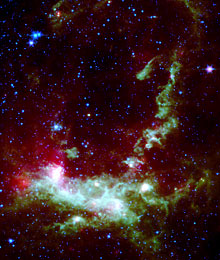
The Spitzer Space Telescope captured the infrared glow of Henize 206, a region of active starbirth in the Large Magellanic Cloud (LMC). According to a new study, star formation in small galaxies like the LMC peaked relatively recently, meaning that starbirth in the universe overall peaked 'only' 5 billion years ago.
Courtesy NASA / JPL-Caltech / Varoujan Gorjian (JPL).
We see lots of stars forming in the universe today, but in fact the most frenzied action has already occurred. Astronomers agree that the star-formation rate all across the cosmos peaked many billions of years ago. But exactly how long ago did this milestone occur, and what was the maximum birth rate of stars compared to today's? Determining this rate is critical to understanding how the universe evolved and took on its present-day character.
A new study by Alan Heavens (University of Edinburgh, Scotland) and three colleagues finds that starbirth peaked about 5 billion years ago, when gas clouds were churning out stars at a clip 6 to 8 times faster than now. Previous studies put the peak 8 billion years ago.
Heavens’s team obtained a different result because it used a novel method for determining the universe's star-formation history. Unlike previous studies, which examined young stellar populations in galaxies at various epochs in cosmic history, Heavens's team studied present-day stellar populations in 96,545 nearby galaxies imaged by the Sloan Digital Sky Survey.
"By analyzing the spectrum of light coming out of a particular galaxy, we can effectively see the entire fossil record of that galaxy at one glance," says team member Raul Jimenez (University of Pennsylvania). "Stars of different masses evolve with different luminosities, so by looking at the integrated spectrum of a galaxy, we can track these different luminosities, their masses, and therefore, how long ago they were born."
To crunch the staggering amount of information contained in the spectra of 96,545 galaxies, Heavens and Jimenez developed a sophisticated data-compression algorithm that made the study possible.

The dotted lines indicate the universe’s star-formation history according to a new study. The peak occurred about 5 billion years ago, in marked contrast to previous studies (shaded area), which put that event about 8 billion years in the past.
S&T illustration; source: Alan Heavens.
In addition to showing that star formation reached a climax 5 billion years ago, star formation apparently remained at a high level from about 12 billion to 2 billion years ago. Another key finding is that star formation in low-mass galaxies peaked more recently than in high-mass galaxies. In low-mass systems, for example, star formation peaked only 2 billion years ago, whereas it maxed out 10 billion years ago (just 3.5 billion years after the Big Bang) in the most massive systems. Previous studies overlooked the contribution of low-mass galaxies, because only high-mass galaxies are bright enough to be visible at large distances.
But for the general picture, all experts agree. Star formation reached its zenith in the distant past, and the universe will never return to its former glory. As stars die and are not replaced by new ones, galaxies will fade gradually to near darkness over the coming tens of billions of years.
The team’s paper is published in the April 8th Nature. The other coauthors are Benjamin Panter and James Dunlop (both at the University of Edinburgh).
 0
0
Comments
You must be logged in to post a comment.